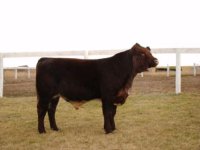TJ
Well-known member
- Joined
- May 15, 2007
- Messages
- 2,036
justintime said:By the way, I was not referring to the cattle on our farm in my rant about not wanting to ever go back to the cattle I saw in the early 60s. I was referring to my experience working part time on one of the breed's top herds at that time. Here on our farm, we had cattle that were too small framed but my dad would never tolerate poor udders and gobby fat cows. This meant that many cows went to town in a relatively short period of time. I have toured though at least 20 herds in the last year, all across Canada and the US... and I maintain that today's herds are composed of much better cattle than there ever was back a few decades ago. Yes, some may need to down size slightly to become more efficient, but that can be obtained in one or two generations with the right sires. Many have spent the best parts of their life times trying to get where they are today, from where they were 30 years ago. Quite honestly, I have seen some excellent herds of true brood cows in the past 3 weeks. Let's concentrate on the good ones.
Thanks for clearing that up. My curiousity is getting the best of me, so I'm going to talk to Ralph the next time I bump into him because I was always under the impression that he thought the older Shorthorn genetics were better than the newer genetics. Now, this was back in the 80's & 90's, but not in the last 10 years. I may ask my dad too because he should remember their Shorthorn cattle very well & he knew other Shorthorn breeders also. Knowing Ralph the way I do, I just couldn't/can't picture the Meacham's with a herd of bad uddered cattle that were fat with no muscle. Smaller framed & easier doing, yes, but those 2 things are not the parts that I am concerned about.

